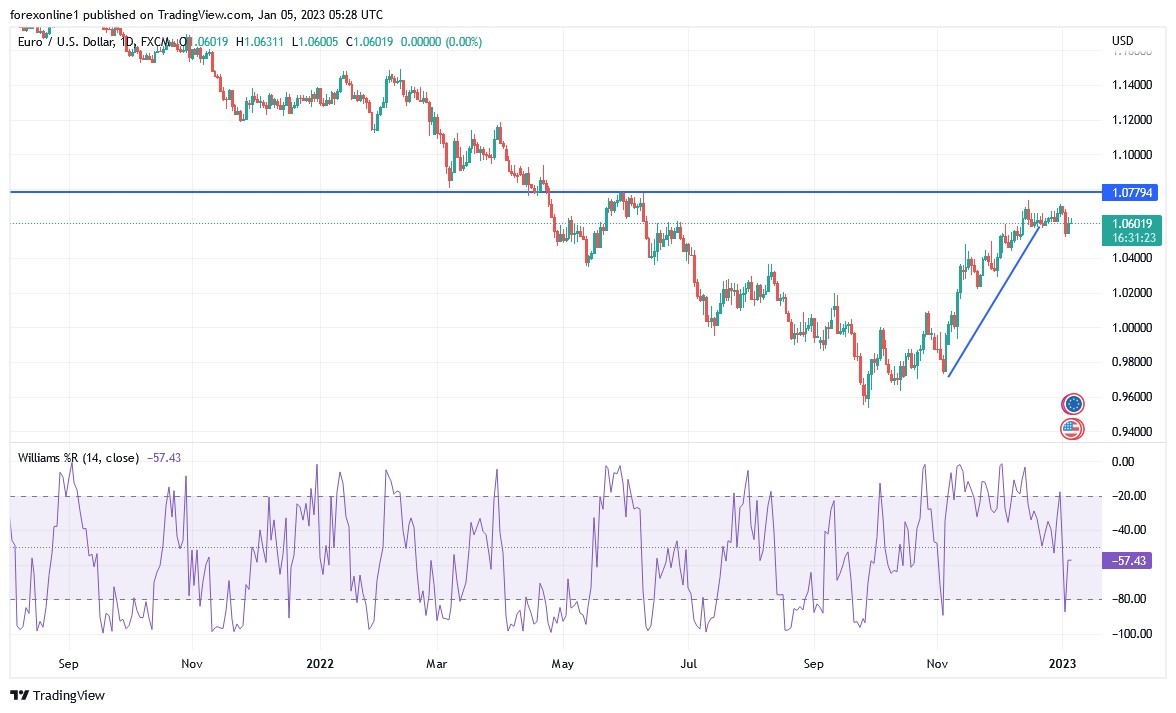Bears still control the performance of the EUR/USD currency pair, with losses affecting the support level 1.0520, before settling around 1.0618 at the time of writing. During this performance, the upcoming FOMC meeting minutes may have a strong impact on the euro's price movement against the dollar, as the Fed's meeting transcript will provide more clues to what the US central bank plans for this year.
The December statement showed a gain of 0.50% as expected, but the tone of the accompanying announcement was more hawkish than expected. For his part, US Federal Reserve Chairman Jerome Powell reiterated that they will not be complacent when it comes to bringing down inflation, which indicates that they may continue to rise until the middle of the year. On the other hand, impressive. The release of the US Nonfarm Payrolls is likely to influence the EURUSD as well, as leading indicators are already pointing to further weakness in the labor market. Analysts expect a slowdown to just 200K in job growth for the month of December.
The euro did not rest much on its gains after the release of weaker-than-expected German inflation data which could indicate that the peak of the European Central Bank's interest rate expectations has now passed. German inflation data for December came in well short of expectations as the eurozone's largest economy benefited from easing energy costs, although underlying inflationary pressures remained.
The euro was softer across the board after statistics agency Destatis reported headline consumer price inflation rose 8.6% y/y in December, below expectations of 9.1% and down substantially from 10% in November. The month-over-month decline came in at -0.8%, nearly tripling the expected reading of -0.3% and accelerating on the -0.5% reported in November.
The euro strengthened in December after the European Central Bank's policy decision in December, as policymakers indicated that more interest rate hikes would be required over the coming months in order to bring inflation back under control. The tone adopted by the ECB surprised the markets and investors raised their expectations for a peak in the ECB's base interest rates and the Euro rose in response. However, should the upcoming inflation data fall off target - as the German numbers did - this "hawkishness" could fade, as some analysts suggest that the "peak" is now behind us.
All in all, the EUR will now look towards Friday's Euro-Zone inflation release to get a clearer idea of how prices are evolving across the region. A strong reading could once again undermine some of the EUR's recent outperformance. Low inflation may have a negative impact on the euro's price, but currency market participants should be aware of other relevant dynamics.
The persistent inflationary impulse in the Eurozone was mainly driven by higher energy prices, particularly gas prices, which threatened economic activity in the Eurozone and raised expectations of a recession in 2023. However, gas prices have fallen sharply over recent weeks while storage levels have remained Good, which indicates a significant improvement in energy security in the region.
This reduces the odds of a deep and damaging recession, which is intrinsically positive for the euro outlook and explains why non-trading currency market participants now hold a net "long" position on the euro. In fact, the single European currency outperformed in December as gas prices fell. We expect more flexibility over the coming weeks if this dynamic continues and gas prices do not rise again.
According to the technical analysis of the pair
- EUR/USD has recently retreated through the bullish trend line support visible on the short-term timeframes, which indicates that a reversal from the upside trend is possible.
- The pair has rebounded from the support around 1.0520 and is pulling up to the resistance levels specified by the Fibonacci retracement tool.
- The price is testing the 50% Fibonacci level but might be able to rise to the 61.8% level near the broken trend line and 1.0650 minor psychological mark.
This also happens to line up with the dynamic resistance at the moving averages. The 100 SMA crosses below the 200 SMA to confirm that the bearish pressure is increasing, which indicates that the resistance levels are likely to stabilize. In this case, EUR/USD may soon make its way to the swing low or lower. Stochastic is also approaching the overbought area to reflect exhaustion among the buyers, so the downtrend could indicate that the sellers are in control. The RSI has a bit more room to run before reaching the overbought area, so the correction may continue until the oscillator turns lower.
Ready to trade our daily Forex forecast? Here’s a list of some of the best Forex brokers to check out.

